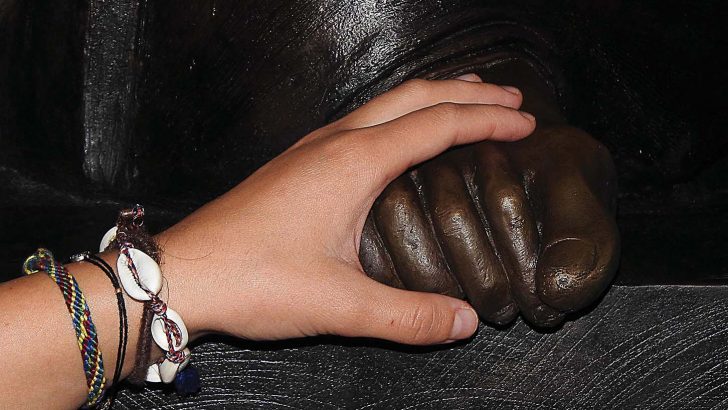We are a people of the incarnation and reaching out to tangible things is important to us, writes Canon Benedict Fee
Three statues; two big, one small; one is in Rome, two in Ireland; one north of the border, one south of the border.
The first is found on the right-hand side of St Peter’s Basilica in Rome. Scholars say it was crafted by Arnolfo di Cambio (1245-1302). But this is disputed with some claiming it may be as old as the 5th Century. It is of course a majestic bronze statue of St Peter but what makes it most noticeable is its right foot. The countless pilgrims to St Peter’s down through the centuries in touching the foot of the statue have eroded and polished the foot so that it no longer looks bronze but rather bright as brass with a warmth and a softness, making it almost fleshy to the touch.
St Oliver Plunkett
The second statue is found far from the marble of Rome, here in Ireland at the town of The Bridge; Drogheda, Co. Louth. The 19th century neo-gothic spire of St Peter’s Parish Church pierces the sky over the banks of the Boyne. Since 1921 St Peter’s Drogheda is also the national shrine of the martyred Archbishop of Armagh, St Oliver Plunkett. Inside the West door as pilgrims progress to venerate the relic of the martyr’s head they pass on the left-hand wall of St Peter’s a miniature copy of the St Peter’s statue of Rome. It came to St Peter’s in 1907 and it seems only right to have this statue here, for St Oliver spent 22 years of his life, as student, priest and professor in the eternal city and no doubt would have touched on occasion the foot of St Peter’s statue.
The foot of this little statue in St Peter’s is now also as bright as brass, polished by the countless pilgrims who for exactly a century this year have honoured the relic of St Oliver here in the parish church of Drogheda.
Lastly, two years ago on July 9, 2019 to honour the 350th Anniversary of the appointment of St Oliver Plunkett to the See of Armagh, Archbishop Eamon Martin unveiled in St Patrick’s Cathedral, Armagh a bronze statue of his martyred predecessor. It is seven foot tall standing on a four foot plinth. It is the work of Dublin-born (now New York-based) sculptor, Dony MacManus. The statue captures the moment when Oliver’s right foot, almost clawed to the ground, teeters on the edge of his execution, at Tyburn on July 1st 1681.
Hearts
The people of Armagh have taken the statue to their hearts, touching the foot as they come and go to Sunday and weekday Masses. No doubt this right foot in time too will lose its brown bronze hue and begin to shine bright as brass and feel warm and soft to the touch.
Isn’t it a strange thing, so much touching; it is said that seeing is believing but perhaps it could even be said that touching is believing more. We are a people of the incarnation, we are of flesh, we are a people of the touch.
In touching a statue of a saint it’s almost as though people want to touch something of the divine.
The statue of St Oliver Plunkett is also the focus of prayer and reflection for all who suffer for the faith in our world today. People like the modern martyr, Fr Ragheed Ghanni, who again like St Oliver studied in Rome while a resident in the Irish College. No doubt he too touched the foot of St Peter and indeed because he worked on the island of Lough Derg during his holidays from Rome, both as student and postgraduate priest, he may have touched the foot of little St Peter in Drogheda too. He was gunned down in Iraq on Holy Trinity Sunday a mere 14 years ago.
Perhaps sometime in the future a statue will be raised to this young priest. People will perhaps touch its right foot praying the Lord to give them the faith of St Peter, and St Oliver and Fr Ragheed too. May they all pray for us.
Of course we are now in a Noli me tangere, (Don’t touch me) time when for the good of each other we have to be careful about the gift of touch. But there will come a day hopefully when we will be able to touch again with faith and hope those whom we love and touch again what we love. Please God soon.
Canon Benedict Fee is parish priest of Clonoe, Co. Tyrone and editor of Not Force Nor Might The Gift of the Martyr, a book of reflections and prayers on and about the statue of St Oliver in Armagh Cathedral.


 The foot of the statue
of St Oliver Plunkett.
The foot of the statue
of St Oliver Plunkett. 